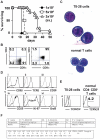Characterization of a new mouse model for peripheral T cell lymphoma in humans
- PMID: 22163033
- PMCID: PMC3230627
- DOI: 10.1371/journal.pone.0028546
Characterization of a new mouse model for peripheral T cell lymphoma in humans
Abstract
Peripheral T cell lymphomas (PTCLs) are associated with a poor prognosis due to often advanced disease at the time of diagnosis and due to a lack of efficient therapeutic options. Therefore, appropriate animal models of PTCL are vital to improve clinical management of this disease. Here, we describe a monoclonal CD8(+) CD4(-) αβ T cell receptor Vβ2(+) CD28(+) T cell lymphoma line, termed T8-28. T8-28 cells were isolated from an un-manipulated adult BALB/c mouse housed under standard pathogen-free conditions. T8-28 cells induced terminal malignancy upon adoptive transfer into syngeneic BALB/c mice. Despite intracellular expression of the cytotoxic T cell differentiation marker granzyme B, T8-28 cells appeared to be defective with respect to cytotoxic activity as read-out in vitro. Among the protocols tested, only addition of interleukin 2 in vitro could partially compensate for the in vivo micro-milieu in promoting growth of the T8-28 lymphoma cells.
Conflict of interest statement
Figures


References
-
- van Hall T, van Bergen J, van Veelen PA, Kraakman M, Heukamp LC, et al. Identification of a novel tumor-specific CTL epitope presented by RMA, EL-4, and MBL-2 lymphomas reveals their common origin. J Immunol. 2000;165:869–877. - PubMed
-
- Dierks C, Adrian F, Fisch P, Ma H, Maurer H, et al. The ITK-SYK fusion oncogene induces a T-cell lymphoproliferative disease in mice mimicking human disease. Cancer Res. 2010;70:6193–6204. - PubMed
Publication types
MeSH terms
Substances
LinkOut - more resources
Full Text Sources
Research Materials

